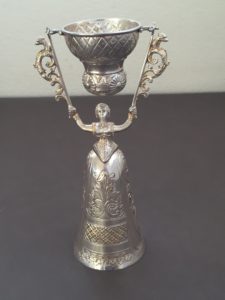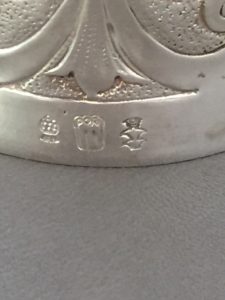 JH sent me something rather extraordinary, if she likes a drinking challenge. In Northern Europe, especially in the 19th century, mature men took this little lady figure, inverted her, and filled her skirt with wine, then filled the swiveling cup. How precarious! The challenge involved drinking out of the little swinging cup while alternatively drinking from the full skirt. This required steady hands. Hence the challenge because the players became, frankly, inebriated. When used this way they called it The Wager Cup. If you think it looks easy, it isn’t, because the swivel on the top cup is very loose.
JH sent me something rather extraordinary, if she likes a drinking challenge. In Northern Europe, especially in the 19th century, mature men took this little lady figure, inverted her, and filled her skirt with wine, then filled the swiveling cup. How precarious! The challenge involved drinking out of the little swinging cup while alternatively drinking from the full skirt. This required steady hands. Hence the challenge because the players became, frankly, inebriated. When used this way they called it The Wager Cup. If you think it looks easy, it isn’t, because the swivel on the top cup is very loose.
Wine cups of this design also performed a role at German wedding ceremonies from the 16th century onward, although collectors find the majority of these from the 19th century. The groom drank out of the skirt and the bride out of the swinging cup, at the same time. Good luck was foretold if they spilled nary a drop. When used in a wedding ceremony, these are Jungfraubecher.
An interesting Origin Story
A major collector, Steveonsteins.com gives an interesting origin story for these beakers. By the way they come in all silver, all pewter, all brass, or a combination of metal with a glass full skirt. The biggest of them reach close to 11 inches, and most are made in the city of the origin story, Nuremberg. Some of the most expensive in private collections include enamel on silver versions with scenes of Nuremberg. For example illustrated on the full skirt. For the finest, most expensive drinking game ever, rare designs are pricey (into the $20K range) featuring a PAIR of drinking cups, one, a king with an ivory face, and his mate, a queen, also with a carved ivory face.
 JH’s cup is rather fine because it’s hallmarked for Augsburg, and ‘flashed’ with gold in the inside of the skirt/cup. We call this flashing vermielle, and it gives a golden shine, with real gold, plated to the surface of silver. A note here, not all silver is sterling. In this case, JH’s cup is 800 parts silver, which is typical of German silver of this era (1890-1900). Sterling is 950 parts silver, the standard for British and American silver, but not for European silver. The lesser inclusion of silver doesn’t lessen the worth of JH’s cup worth because content is different across historical locations.
JH’s cup is rather fine because it’s hallmarked for Augsburg, and ‘flashed’ with gold in the inside of the skirt/cup. We call this flashing vermielle, and it gives a golden shine, with real gold, plated to the surface of silver. A note here, not all silver is sterling. In this case, JH’s cup is 800 parts silver, which is typical of German silver of this era (1890-1900). Sterling is 950 parts silver, the standard for British and American silver, but not for European silver. The lesser inclusion of silver doesn’t lessen the worth of JH’s cup worth because content is different across historical locations.
Fable Behind the Invention of the Drinking Challenge
400 years ago, in Nuremberg, an old goldsmith had a beautiful daughter, who he wagered would bring a good dowry. But the old goldsmith’s young apprentice loved the daughter, and the daughter returned his attentions in secret. The old smith discovered their passion He commanded them to never marry unless they discovered a wine cup that made drinking together out of one connubial beaker possible. The young goldsmith rose to the occasion and forged the first Jungfraubecher. To top it off, he showed the elderly goldsmith his daughter co-creatored the novel design, and she COULD drink with him in unison.
JH always loved the little drinking cup but never figured out its purpose, or where the cup was made. She believes her grandmother used it. JH, I suspect your grandmother’s mother, or her mother, saved it as a souvenir of her wedding, because people typically passed them down through the generations.
Standard Features Seen on Every Jungfraubecher
A young woman, attractively shaped, ample bosom and small waist, long graceful hands holding the small cup aloft, always smiles. The origin fable tells us her smile and shapely form comes from the goldsmith who desired the beautiful daughter and used his lady love as the model for the prototype.
The hallmark dates the cup to 1890-1900, before the onslaught of WWI, an era in Germany that celebrated medieval German traditions, with a definite flavor of medieval design. This era also saw great wealth among the upper middle-class. Not uncommonly families of wealth owned a solid silver wedding or wager cup handmade. JH, your unique cup is worth $800-1,000, and is sought after in this excellent condition. My question: have you attempted to drink from it, either solo, or with your lover?
This is such a cool story. I’ve seen these cups but had no idea of the origin. Leave it to you Elizabeth to explain with such loving detail. Thank you